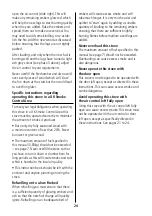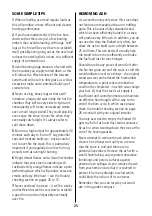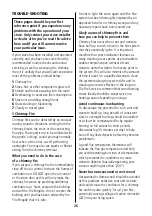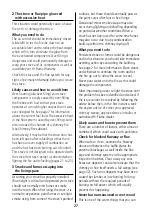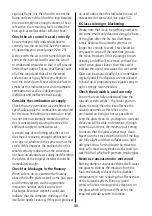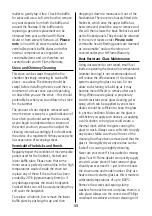
20
ESSENTIAL SAFETY ADVICE
• Ensure that an approved carbon monoxide
(CO) detector (BS EN50291:2001) is fitted in
the same room as the stove and is regularly
tested. The CO alarm must be installed strictly
in accordance with the manufacturer’s
instructions and permanently fixed so that it
is best placed to monitor the earliest signs of
CO escape. It should be powered by a battery
designed for the working life of the alarm
(usually five years). Hi-Flame recommend
Honeywell or Fire Angel models. Do not be
tempted to buy a cheap alarm as recent
research by the UK consumer organisation
Which? has shown that many of the cheapest
models simply do not work effectively.
• Never operate this stove with the door open
except as directed in these instructions and
when this should be kept to a minimum and
the stove not left unattended.
• External surfaces including the firechamber
door and handle, window, air control, flue
pipes and stove bodywork will become
extremely hot. Always avoid touching these
parts of the stove without proper protection,
such as heat resistant gloves.
• Potentially combustible material or objects
such as soft furnishings should never be left
on or near any of the stove’s hot surfaces. En-
sure that wood supplies and log baskets are
kept at a safe distance from the stove. Never
dry clothes on the stove.
• Never leave children unattended in the
room where your stove is being operated.
Ensure that children are aware of the potential
danger and make sure that they keep clear
of the stove when it is in operation. Where
children, the elderly or the infirm are present,
to prevent accidental contact with the stove,
always use a safety fireguard manufactured in
accordance with BS8423:2002, Fireguards for
use with solid fuel appliances.
WATCH
OUT
!
CARBO
N MON
OXIDE
KILLS
• For your safety make sure that your stove’s
installation complies with all local Building
Regulations’ ventilation requirements. Low
energy houses have particular requirements
and these should be strictly adhered to.
• Do not use flammable liquids to ignite the
fire. In the confined space of the firechamber
there is a real potential to cause a life
threatening flash flame or explosion.
• Never over-fire the stove. If any external
parts of your stove glow red during operation
then immediate action should be taken to
reduce the supply of air to the firechamber
through the air control which should quickly
limit the intensity of the fire. Do not open the
firechamber door as this will only make the
fire worse. See pages 26 and 27.
• This stove is CE approved and tested to EU
EN13240 standards in Europe by SGS
Nederlands BV. Alterations to its construction
could be potentially dangerous and will render
your Hi-Flame Warranty void.
• Do not use aerosol products in the vicinity
of the stove when it is in use.
• Check and clean the stove’s flueway and
the top of baffle plate regularly to help avoid
potential blockages (see page 32).
• Check the direct external air system’s
outside vent’ grille to ensure there are no
blockages arising from new foliage growth,
wind-blown debris and leaves or snow drifts.
• Sweep your chimney or flue system regularly.
Always use an approved sweep who has
experience of sweeping stove
installations.



















